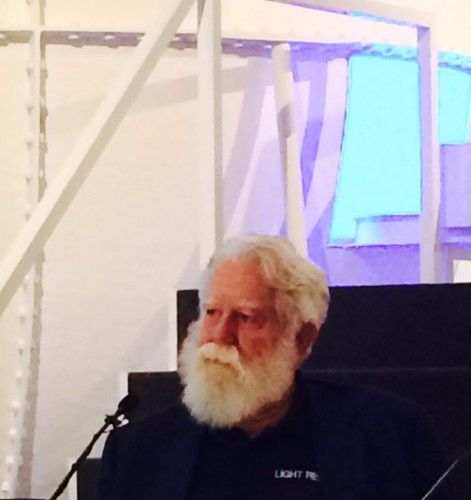TO the director of the National Gallery of Australia, Gerard Vaughan, James Turrell is “one of the world’s most phenomenal artists.”
And he meant that word “phenomenal” quite literally, for in the new exhibition “James Turrell: a retrospective”, the artist can be seen treating light as a material, so that “the spiritual and technological merge.”
Vaughan had good reason to be self congratulatory. Advance ticket sales, he told press assembled for a media preview this morning, were very strong and tickets to the “The Perceptual Cell” installation had sold out for December.
New to the NGA, Vaughan has been popping in to watch what he said was “the most complicated installation I’ve ever been involved with,” as the enormous spaces of Colin Madigan’s National Gallery building were filled with the equivalent of several buildings.
And he had an announcement to make – the acquisition of six major works by Turrell—a key work for each decade of his artistic career. In this way, Vaughan said, the National Gallery of Australia could now match other international galleries in its Turrell holdings, adding to “Sky space”, which he said, was “one of our most popular works.”
Seated before “The Perceptual Cell”, Turrell described the show as “one of the most beautifully-made of all my exhibitions.”
He spoke of his long relationship with the NGA to which he had first come 18 years and 4 directors ago. “I’ve been to Canberra, more often than many Australians,” he boasted.
Turrell was more modest about the technological aspects of his work, saying that most creations were “quite simple… It’s just to do with the effect of light upon you.” But he did concede, using the principle ‘slow and steady wins the race’, that he had laboured slowly for 50 years and an exhibition like this proved “how the turtle wins.” Indeed, a newspaper had once dubbed him James Turtle.
Asked whether it was important to know about the technology behind his exhibits, he drew the parallel with piano-playing, suggesting that it was inappropriate to say after a brilliant performance, “what a fantastic machine that is!” In other words, he would prefer people to react to the light, pure and simple.
‘Light is part of our daily diet,” Turrell said, thinking about vitamin D. But it was also an important feature of St Paul’s Damascus Road conversion, one of the many examples he could cite of people using “the vocabulary of light.” With celebrated artists from Rembrandt to the Impressionists praised for their use of light, he felt confident that “this exhibition is not outside the history of art.”
“You can’t form light like clay,” Turrell concluded, “it’s more like playing an instrument.”
“James Turrell: a retrospective”, at the National Gallery of Australia, from December 13, timed entry sessions with limited capacity. Bookings to 1300 795012.
The post Turrell’s art: ‘like playing an instrument’ appeared first on Canberra CityNews.

